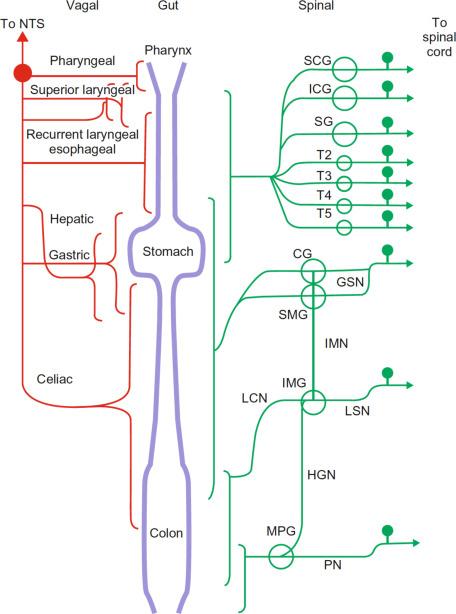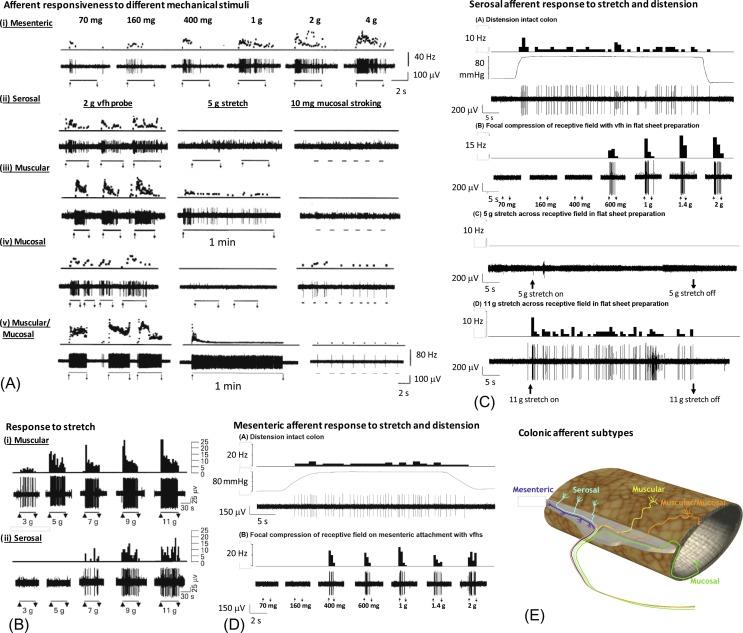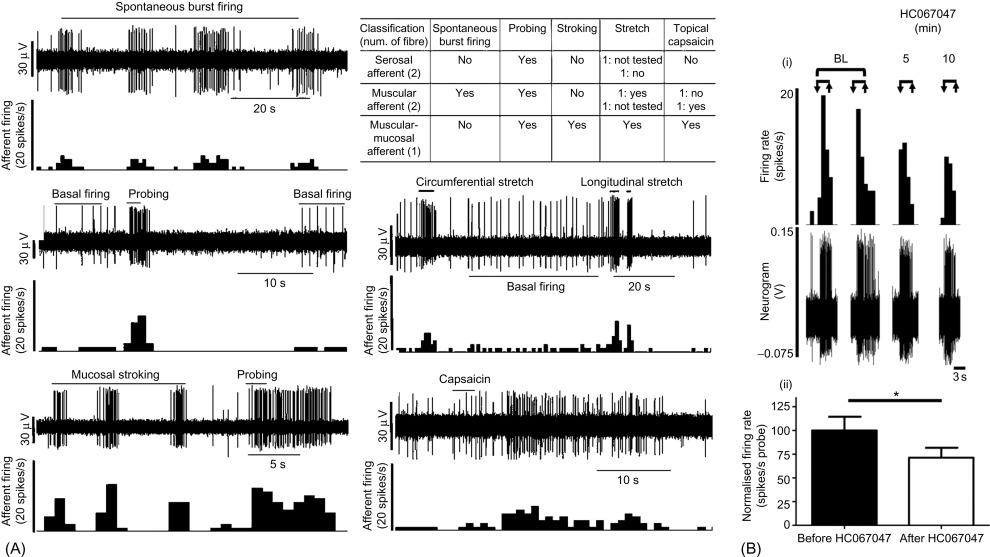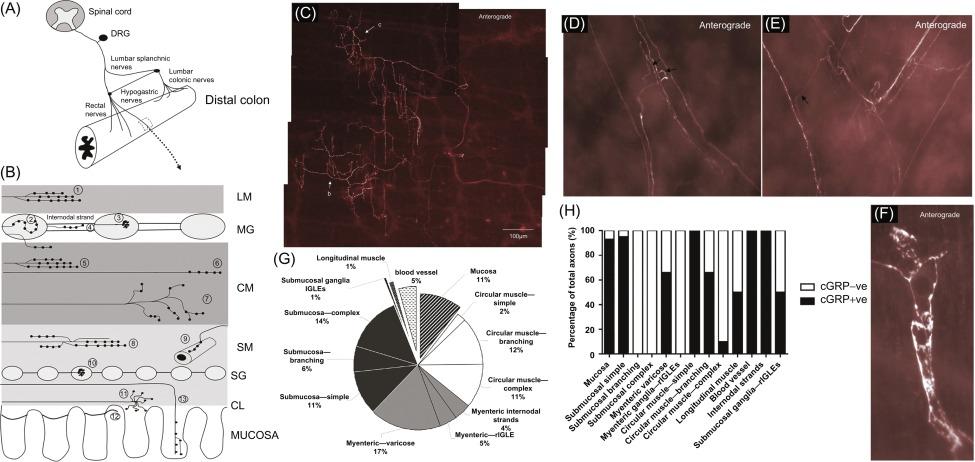Physical Address
304 North Cardinal St.
Dorchester Center, MA 02124
4-hydroxynonenal
5-HT receptor
acid sensing ion channel 1
acid sensing ion channel 2
acid sensing ion channel 3
calcitonin gene-related peptide
central nervous system
colorectal balloon distension
chronic visceral hypersensitivity
chronic visceral pain
dorsal horn
dorsal root ganglia
dextran sodium sulfate
γ-aminobutyric acid
γ-aminobutyric acid receptor B
G-protein coupled receptor
G protein coupled receptor kinase 6
histamine 1 receptor
histamine 4 receptor
inflammatory bowel disease
irritable bowel syndrome
irritable bowel syndrome with alternating or mixed motility
constipation-predominant irritable bowel syndrome
diarrhea-predominant irritable bowel syndrome
intraganglionic laminar endings
interleukin-1β
interleukin-6
intramuscular arrays
mechanically insensitive afferents
myeloperoxidase
voltage-gated sodium channel
nucleus of the solitary tract
oxytocin receptor
protease-activated receptor 2
protease-activated receptors
peripheral blood mononuclear cells
parabrachial nucleus
postinfectious irritable bowel syndrome
transient lower esophageal sphincter relaxations
trinitrobenzene sulfonic acid
tumor necrosis factor-α
transient receptor potential
transient receptor potential ankyrin repeat
transient receptor potential (TRP) melastatin related
transient receptor potential (TRP) vanilloid binding
visceromotor response
ventral posterolateral
delta-opioid receptor
kappa-opioid receptor
mu-opioid receptor
Stuart M. Brierley is a National Health and Medical Research Council of Australia (NHMRC), R.D Wright Biomedical Research Fellow ( APP1126378 ). Andrea M. Harrington received funding via the Australian Research Council (ARC) Discovery Early Career Research Award (DE130100223).
Our ability to detect and perceive mechanical and chemical stimuli is vital in determining how we respond to environmental challenges. Detection of external stimuli by sensory afferents innervating our skin and joints is responsible for our senses of touch, proprioception, and aspects of pain. While we may not always be aware of it, specific classes of extrinsic sensory afferents also detect ongoing changes in the physical and chemical environment within the lumen and wall of our gastrointestinal tract. These sensory afferents are subdivided on the location of their soma. Vagal afferents have cell bodies located within the nodose/jugular ganglia and project centrally to the brainstem, while spinal afferents have cell bodies in multiple dorsal root ganglia (DRG) and project centrally to the dorsal horn of the spinal cord. These afferents convey information that underlies the initiation of autonomic reflex control and all manner of visceral sensations, including chronic visceral pain (CVP). This chapter has several aims: (1) To map out the anatomy of the sensory afferents innervating the gastrointestinal tract. (2) Summarize the key functional classes of afferent endings located throughout the gastrointestinal tract. (3) How the function of these afferents is altered in clinically relevant disease states. (4) Highlight the key molecular and cellular peripheral markers that are altered in samples from patients with clinical gastrointestinal disorders. (5) Highlight the key ion channels and receptors that are expressed by extrinsic sensory afferents innervating the gastrointestinal tract that underlie afferent hypersensitivity, but serendipitously present potential opportunities for the therapeutic treatment of CVP.
The cell bodies of vagal afferents reside in either the bilateral nodose ganglia or the bilateral jugular ganglia, located at the base of the skull ( Fig. 17.1 ). The nodose and jugular ganglia are embryologically distinct, with nodose neurons arising from the epibranchial placodes, while jugular neurons derive from neural crest cells of the postotic hindbrain, more akin to spinal afferents. The central projections of gastric vagal afferents have their terminals predominantly within the subnucleus gelatinosus of the nucleus of the solitary tract (NTS). Within the NTS, esophageal afferents project to the subnucleus centralis, whereas afferents innervating the gastric mucosa and muscle project to overlapping regions of the NTS. Additionally, there is a small proportion of mucosal afferents that project into the medial subnucleus. Overall, there are diverse projections from the NTS into a large range of nuclei throughout the brain, which are involved with behavioral, cognitive, and autonomic processing. The axons of vagal afferents travel via the paired dorsal and ventral vagal nerve trunks before organ-specific branches project into thoracic and abdominal organs, including the esophagus, stomach, and small intestine. The density of vagal afferent endings is greatest within the stomach and esophagus, reduces in the small intestine, and are absent in the distal colon and rectum. Vagal afferents innervate all layers of the wall of the upper gastrointestinal tract. They include various types of mucosal endings, intraganglionic laminar endings (IGLEs), and intramuscular arrays (IMAs), which are discussed in detail below. In keeping with their distribution and function, vagal afferents are generally associated with signaling physiological events in the upper gastrointestinal tract, such as fullness and satiety.

The cell bodies of spinal afferents are located within the cervical, thoracic, lumbar, and sacral DRG, located bilaterally adjacent to the spinal cord. The precise regional location of the DRG depends upon the gastrointestinal region. The spinal afferent innervation of the gastroesophageal region spans from the cervical to the thoracic and upper lumbar segment of the spinal cord via axons traveling through the thoracic spinal and greater splanchnic nerves ( Fig. 17.1 ). The spinal afferent innervation of the small intestine spans from the thoracic to the lumbar spinal cord via the greater splanchnic nerves ( Fig. 17.1 ). The proximal colon receives spinal innervation from the thoracic to the lumbar spinal cord via the lumbar splanchnic nerve, while the distal colon receives dual innervation from the lumbar splanchnic nerve and sacral pelvic nerves. The rectum also receives innervation from the lumbosacral spinal cord via the sacral pelvic nerves ( Fig. 17.1 ). Spinal afferents innervate all layers of the wall of the gastrointestinal tract. They include various types of mucosal endings, IGLEs, IMAs, and in particular afferents that wrap around blood vessels, which are discussed in detail below.
The central terminals of spinal afferents project into discrete laminae of the superficial dorsal horn and make synaptic contacts with second-order neurons within the dorsal horn of the spinal cord. Spinal afferents supplying the upper gastrointestinal tract, such as the esophagus and small intestine, are distributed along the cervical and thoracic spinal cord (C1-T12), with peaks of innervation present in C2-C6, T2-T4, and T8-T12. Lumbar splanchnic fibers innervating the colon terminate within the thoracolumbar spinal cord (T10-L1), whereas sacral pelvic afferents innervating the distal colon and rectum terminate within the lumbosacral spinal cord (L6-S2). The central terminals of afferents innervating the distal colon are localized within the thoracolumbar spinal cord. They project into the superficial dorsal horn lamina I and transverse along mid and lateral collateral pathways of Lissauer into lamina V. The projection pattern of pelvic nerves in the lumbosacral spinal cord differs from that observed in the thoracolumbar spinal cord for the splanchnic nerves, with studies showing terminals present in the lumbosacral superficial dorsal horn lamina I and more prominently in Lissauer's lateral collateral tracts projecting into laminae V and VI and medial tracts projecting into the dorsal commissure and spinal dorsal columns. The types of dorsal horn neurons activated by visceral stimuli differ between spinal segments. Within the thoracolumbar spinal cord, lamina I projection neurons and interneurons are activated by visceral stimuli. In the lumbosacral spinal cord, a greater number of interneurons and dorsal column neurons are responsive to colorectal distension relative to that observed in the thoracolumbar spinal cord. From the spinal cord, dorsal horn lamina I projection neurons relay visceral specific sensory information to higher central nervous system (CNS) centers via the ascending spinothalamic tracts. In addition, lamina I spinoparabrachial projection neurons relay visceral input into the parabrachial nucleus (PBn), which transmits to higher-order centers for nociceptive processing. The dorsal column is also important in the transmission of visceral pain, with postsynaptic spinal dorsal column neurons activated by visceral stimuli and transferring input into the ventral posterolateral (VPL) nucleus of the thalamus. Dorsal column neurons responsive to visceral stimuli are prominent in the lumbosacral spinal cord, located in laminae III-IV, and around the central canal area. Given their distribution throughout the gastrointestinal tract and their function, spinal afferents are generally associated with higher-threshold sensations such as discomfort, bloating, urgency, and pain.
Vagal and spinal extrinsic sensory afferents innervating the gastrointestinal tract have been studied for decades in a variety of animal species including mice, rats, ferrets, cats, guinea pigs, sheep, rabbits, and also humans. Generally speaking, these vagal and spinal afferents have been recorded and subdivided on the basis of their mechanical responsiveness to a variety of stimuli, their mechanical activation thresholds, and their perceived location within the various layers of the gastrointestinal tract. In this chapter, for simplicity, we highlight five main functional classes of afferents, which include (1) low-threshold mucosal afferents that are highly sensitive to distortion of the gastrointestinal mucosa, (2) muscular (or tension) afferents that respond with a wide dynamic range to circular stretch/distension, (3) muscular/mucosal (or tension/mucosal) afferents that respond to both mucosal distortion and circular stretch, and (4) vascular endings that wrap around blood vessels in the mesentery, serosal, and submucosal space and respond to high-threshold stimuli ( Fig. 17.2 ). Notably, these four different classes of afferent have been confirmed to be present in recordings from human colon ( Fig. 17.3 ), which highlights the utility of preclinical studies. The fifth class, termed mechanically insensitive afferents (MIA) or silent afferents, gain the ability to respond to mechanical stimuli following activation by inflammatory or immune mediators. As discussed below, the majority of these afferent classes have conduction velocities in the C-fiber range and are predominantly peptidergic, while many afferent endings display specialized anatomical structures, rather than the traditionally perceived “free nerve endings” ( Fig. 17.4 ). These terminal structures, combined with a various arsenal of ion channels and receptors to regulate their neuronal excitability, underlie the vastly different sensory functions of spinal afferent classes.



Vagal and spinal mucosal afferents are sensitive to light stroking or compression of the gastrointestinal mucosa. They generate a brief burst of action potentials each time the stimulus passes over its associated receptive field. Mucosal afferents constitute half of afferents in the upper gastrointestinal tract, and are generally silent at rest. They are not sensitive to distension or contraction of the gut, and given their exquisite sensitivity to low-threshold stimuli, they play a crucial role in detecting the particle size of luminal contents. Within the esophagus, mucosal afferents may provide feedback to reflexes controlling peristaltic contraction, while in the stomach and small intestine they likely regulate the initiation of satiety, nausea, vomiting, as well as regulating gastric emptying. Within the colon, mucosal afferents are rare, representing only 4%–23% of the total fibers recorded from the splanchnic nerves of mouse and rat. In the distal colon and rectum, mucosal afferents are more frequently observed in the pelvic innervation, representing 23%–38% of all afferents recorded. This increased role of mucosal afferents in the distal colon and rectum is important, due to a need for information about stool consistency as material passes distally. Accordingly, pelvic mucosal afferents are likely to be involved in the control of defecation and likely contribute to conscious perception of stool passage in the rectum and anal canal. The anatomy of mucosal afferents from the pelvic nerve has recently been identified in the distal colon of mice, with 11% of all the pelvic afferent endings projecting into the mucosa. These fibers consist of single or branched fine varicose axons that ramify within the mucosa, with the vast majority (> 90%) of mucosal endings found to be calcitonin gene-related peptide (CGRP) positive.
Gastrointestinal afferents that are responsive to low-intensity stretch, distension, or contractions have been referred to as tension (vagal gastroesophageal), low-threshold and wide-dynamic range (jejunal afferents), or muscular (spinal colonic afferents). Vagal afferents in the upper gastrointestinal tract often have a resting discharge of action potentials that is increased in response to contractions and distension. Accordingly, tension afferents signal the amplitude, pattern, and direction of luminal contractions to the CNS, which is important in triggering reflexes controlling gastrointestinal function. Anterograde tracing studies have identified IGLEs as the anatomical equivalent of the tension receptor. IGLEs are lamellar structures that originate from a parent axon and extend into and cover the myenteric ganglia. Anatomically, IMAs have also been identified, which are specialized structures within the circular and longitudinal muscle layers that range in size from several hundred microns to several millimeters. Accordingly, IMAs have been suggested to be tension receptors, length receptors, or a combination of both. Although these endings are likely mechanosensitive, little physiological evidence exists for their actual function.
In the jejunum, three different subtypes of vagal or spinal afferent can be classified on the basis of their response to distension. They are termed low-threshold, wide-dynamic range, and high-threshold afferents. In terms of the afferents responsive to low-intensity distension, the low-threshold afferents probably represent vagal afferents, with the wide-dynamic range afferents representing spinal afferents. However, to date, their anatomy remains to be conclusively determined.
In the colon and rectum, muscular afferents respond to low-distension pressures (e.g., < 20 mmHg; or low-intensity stretch stimuli (< 3 g; ), within the physiological range caused by the propulsion of fecal matter. Muscular afferents are prevalent in the pelvic pathway (21% of all mechanosensitive afferents) and are found in both the distal colon and rectum. In contrast, muscular afferents are relatively rare in the splanchnic pathway (10% of all mechanosensitive afferents). Pelvic muscular afferents also have slower adaptation rates to maintained distension. These afferents recorded in ex vivo mouse preparations are similar to those recorded previously in vivo in the pelvic nerve of cats and rats and in the splanchnic nerves of cats. The anatomical transduction sites of rectal muscular afferents have been identified as flattened branching endings in the myenteric ganglia called rectal IGLEs. They are morphologically similar to vagal IGLEs, but are smaller, simpler, and display less extensive branching. As muscular afferents are responsive to contraction of both the circular and longitudinal muscle they are likely excited by physiological levels of distension in the distal colon and rectum that provide information that is important for reflex loops and defecatory pathways.
While distinct classes of mucosal and muscular afferents have been clearly identified, there is a separate class of afferent that respond to both light mucosal distortion and by low-threshold distension or contraction. These afferents have been termed tension/mucosal in the upper gut, and muscular/mucosal in the distal colon and rectum. The vagal tension/mucosal afferents have been observed in the gastroesophageal regions of the ferret. These vagal afferents may have a specialized role in the detection of rapidly moving boluses of food and/or liquid along the esophagus. Spinal muscular/mucosal afferents have only been localized in the pelvic innervation of the distal colon and rectum of the mouse. They represent ~ 25% of the total pelvic innervation and respond in the same way as both mucosal and muscular afferents. Interestingly, these afferents have not been observed in the splanchnic innervation of the distal colon, suggesting that they may play a key role in spinal defecatory circuits and conscious sensation. Recent tracing studies have identified a remarkably complex array of different morphological types of pelvic afferent endings in many anatomical layers of the colorectum. While it has yet to be confirmed, there are identified endings within the submucosal ganglia, and innervating the Crypts of Lieburkuhn, that may be the anatomical correlate of muscular/mucosal afferents.
Become a Clinical Tree membership for Full access and enjoy Unlimited articles
If you are a member. Log in here